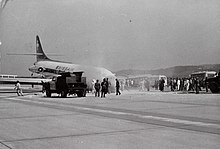
Summary
China Airlines Flight 825 was a scheduled China Airlines passenger flight from Taipei's Songshan Airport to Kai Tak Airport, Hong Kong. On 20 November 1971, a Sud Aviation SE-210 operating this route disintegrated in midair over the Penghu islands, killing all 25 onboard.[1]
 The aircraft involved after the Swissair 142 accident | |
| Bombing | |
|---|---|
| Date | 20 November 1971 |
| Summary | In-flight explosion caused by bombing |
| Site | Penghu, Taiwan 23°32′40.3″N 119°23′08.2″E / 23.544528°N 119.385611°E |
| Aircraft | |
| Aircraft type | Sud Aviation SE-210 Caravelle III |
| Operator | China Airlines |
| Call sign | DYNASTY 825 |
| Registration | B-1852 |
| Flight origin | Songshan Airport, Taipei, Taiwan |
| Destination | Kai Tak Airport, Hong Kong |
| Passengers | 17 |
| Crew | 8 |
| Fatalities | 25 |
| Survivors | 0 |
Aircraft edit
The aircraft involved was a Sud Aviation SE-210 Caravelle III built in March 1962, first delivered to Swissair with registration HB-ICT. The aircraft was involved in a separate accident as Swissair Flight 142, on 25 April 1962, where it experienced problems with its nose landing gear enroute from Geneva, Switzerland to Paris, France. Due to unsatisfactory maintenance and a lack of fuel, the flight was diverted by air traffic control (ATC) to Zurich Airport. The aircraft then landed at Zurich with the nose gear retracted, causing a fire to break out underneath the cockpit. All 72 people on board were evacuated safely.[2] The aircraft was repaired and returned to service.
On 12 January 1971, the aircraft was delivered to China Airlines.[3]
Events edit
On 20 November 1971, prior to the incident, the aircraft landed safely at Taipei as Flight 823 from Osaka, Japan via Naha and completed this flight without incident.
The aircraft then departed Taipei as China Airlines Flight 825 at 21:02 local time and was expected to arrive at Kai Tak Airport at 22:50. The captain was Wei Pu-hsiao and the first officer was Chü Chi-ping. There were 10 passengers on board other than the Taiwanese passengers: 3 Japanese, 3 Iranians, 2 Singaporeans, 1 Vietnamese, and 1 Brazilian, Lauro Muller Neto, Brazil's ambassador to Taiwan at the time.[4]
Flight 825's last communication with ATC was made at 21:33 while at 26,000 feet (7,900 m) and contact was lost 17 minutes later at 21:50. The aircraft crashed into the Taiwan Strait, killing all 17 passengers and 8 crew members on board.[5]
The Taiwan Garrison Command investigated the crash, which concluded that the in-flight break up was the result of a terrorist bomb explosion. The reasons for the bombing could not be determined.[6]
| Nationality | Passengers | Crew | Total |
|---|---|---|---|
| Taiwan | 7 | 8 | 15 |
| Japan | 3 | - | 3 |
| Iran | 3 | - | 3 |
| Singapore | 2 | - | 2 |
| South Vietnam | 1 | - | 1 |
| Brazil | 1 | - | 1 |
| Total | 17 | 8 | 25 |
References edit
- ^ Ranter, Harro. "ASN Aircraft accident Sud Aviation SE-210 Caravelle III B-1852 Penghu Island". Aviation Safety Network. Flight Safety Foundation. Archived from the original on 2012-03-15. Retrieved 2021-05-03.
- ^ Ranter, Harro. "ASN Aircraft accident Sud Aviation SE-210 Caravelle III HB-ICT Zürich-Kloten Airport (ZRH)". Aviation Safety Network. Flight Safety Foundation. Archived from the original on 2019-10-22. Retrieved 2021-05-03.
- ^ "Fleet - Caravelle". sr692.com. Archived from the original on 2015-09-24. Retrieved 2014-04-18.
- ^ "Plane carrying 25 lost". Corpus Christi Caller-Times. 1971-11-21. p. 4. Archived from the original on 2019-05-14. Retrieved 2014-04-19.
- ^ Gero, David (1997). Air terrorism. Ikaros Publishing. p. 158. ISBN 4-87149-127-7.
- ^ "Crash of a Sud-Aviation SE-210 Caravelle III off Penghu Islands: 25 killed". baaa-acro.com. Bureau of Aircraft Accidents Archives. Archived from the original on 2020-10-01. Retrieved 2021-05-03.


